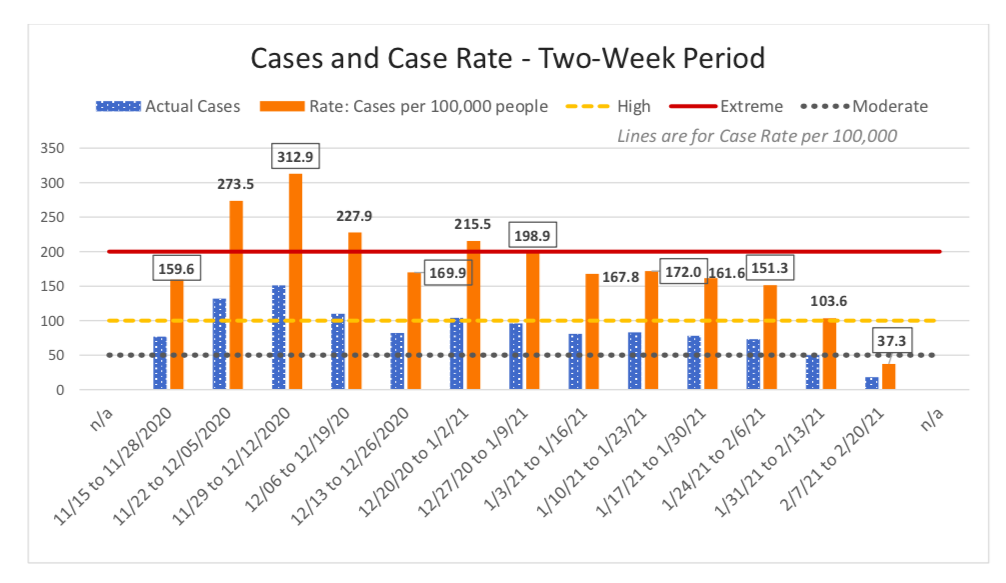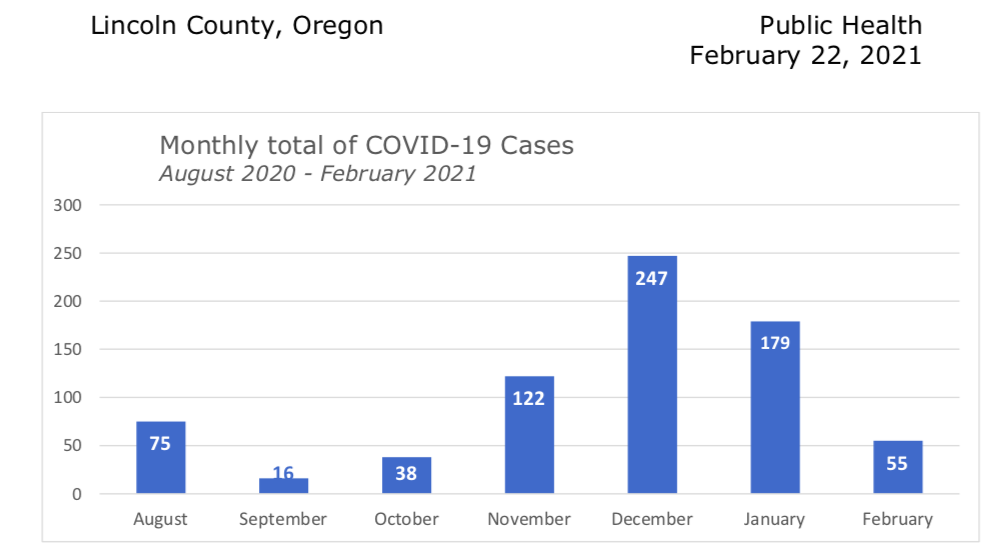
The number of COVID-19 cases in Lincoln County has dropped so dramatically the past month that it will be one of three Oregon counties Friday that will relax heavy restrictions on social and business activity to much looser state controls.
Lincoln and nine other of Oregon’s 36 counties will be classified effective Friday as “low risk” for spreading the COVID-19 virus. Lincoln County will have dropped from its current “high risk” level of restrictions past “moderate” all the way to “low risk.”
Although a 20th county resident was reported to have died of COVID-19 related issues Tuesday, there have been just 18 cases in the two-week period ending Saturday. That contrasts with 75 cases in the two week period ending Feb. 6.
While the state’s restrictions have been gradually loosening, the drop into the “low risk” category means some more changes in Lincoln County, including:
- The Lincoln County School District will now offer contact 8- and 11- man football for its four high schools because it will no longer be required to test players for COVID-19 or conduct contract tracing should someone catch the virus. Under the previous “high risk” category, the district was going to 7-on-7 non-contact football, drawing the ire of some high school parents. The district said Tuesday it is still evaluating if it will allow some spectators at athletic events, which it so far had not planned to do.
- Social gatherings can have up to 12 people from four households;
- 50 percent capacity at restaurants and bars, up for 25 percent, and up to eight people per table, and a closing time of midnight;
- Indoor entertainment like theaters and aquariums increase to 50 percent capacity from 25 percent;
- Churches move to 75 percent capacity from 50 percent;
- Limited office work is allowed;
- And, outdoor full-contact sports are permitted.

The change in Lincoln County is being felt statewide, as the number of COVID-19 cases plummets.
Case have dropped 44 percent nationwide over the past 14 days, according to the New York Times survey of state health agencies. Deaths are down 28 percent in the same period.
Oregon was part of the trend, with a 34 percent drop in cases and a 54 percent decline in deaths.
Oregon continues to rank 49th out of 50 states on a key measure that averages cases over seven days and adjusts the number for infections per 100,000 people. Oregon has 9 cases per 100,000. Only Hawaii, with three, had a lower mark. Among Oregon’s neighbors, Washington and Nevada each had 11. California was at 17. The worst rates were in South Carolina, at 46 and New York at 38.
Public health officials are hopeful that the trend will continue as the slow pace of vaccination picks up in coming months.
Sixteen of Oregon’s counties are improving their infection risk levels, including 10 that are moving off the extreme risk tier.
Gov. Kate Brown said Tuesday that 10 of the state’s 36 counties were dropping off the extreme risk tier.
Among the larger cities that will see less restrictions are Eugene, Salem, Medford, Beaverton, Albany, McMinnville, Ontario, Oregon City and The Dalles.
“We are seeing great progress in stopping the spread of COVID-19 across Oregon and saving lives,” Gov. Kate Brown said Tuesday in announcing the changes. “Oregonians continue to step up and make smart choices.”
Five counties — Benton (Corvallis), Coos (Coos Bay), Jefferson (Madras), Josephine (Grants Pass) Douglas (Roseburg) — remain at the extreme risk level. That compares to 26 counties in late November at the height of the holiday spike in infections.
The state’s four-tier risk level rates counties at lower, moderate, high and extreme levels for COVID-19 spread. Ranking is determined by measures including total cases, cases per 100,000 people and positive infection rate. The higher the level, the more restrictive the rules on businesses and activities.
The levels are adjusted every two weeks. The ratings announced Feb 9 expire Thursday. The new ratings go into effect Friday. Announcement of the next level changes will be March 9 and will go into effect March 12.
Some of the state’s most populous counties improved their level, although Portland just missed the mark. Washington and Clackamas counties near Portland moved from high to moderate risk. Neighboring Multnomah County, which includes Portland, was just above the cut-off point for cases per 100,000.
Major counties moving off the extreme level list to high level include Lane (Eugene, Springfield and Florence), Umatilla (Pendleton), Marion (Salem), Jackson (Medford and Ashland), and Linn (Albany).
The coastal counties were an odd split. Clatsop County (Astoria) posted the lowest number of COVID-19 cases in the state when adjusted for population: 30.5 per 100,000. The second lowest number was in Lincoln County (Newport, Lincoln City), with 37.3 cases. Both counties moved from high to lower risk level. Tillamook County remained at lower risk level.
Measuring the coastal infection rate is problematic because two counties, Lane and Douglas, stretch from the Pacific Ocean to the Cascades.
But the southern most coastal counties are the flip side of the virus rates in the north coast. Coos County remains in the extreme risk level, while Curry County (Brookings, Gold Beach) saw infections rise and its risk level increased from lower to moderate.
Three counties saw their risk level increase due to rising infections. Douglas County (Roseburg), the state’s ninth most populous county, rose from high to extreme. Harney and Curry counties moved from lower to moderate risk. All three will have to reinstitute restrictions for a minimum of two weeks.
Lower Risk (10): Baker, Clatsop (Moved from high), Gilliam, Grant, Lincoln (Moved from high), Sherman, Tillamook, Wallowa, Wasco (Moved from extreme), and Wheeler
Moderate Risk (10): Clackamas (Moved from high), Curry (Moved from lower), Harney (Moved from lower), Hood River (Moved from high), Lake, Linn (Moved from high), Malheur (Moved from extreme), Morrow, Union (Moved from extreme), and Washington (Moved from high).
High Risk (11): Columbia, Crook (Moved from extreme), Deschutes, Jackson (Moved from extreme), Klamath, Lane (Moved from extreme), Marion (Moved from extreme), Multnomah, Polk (Moved from extreme), Umatilla (Moved from extreme), and Yamhill (Moved from extreme).
Extreme Risk (5): Benton, Coos, Douglas (Moved from high), Jefferson, and Josephine.


